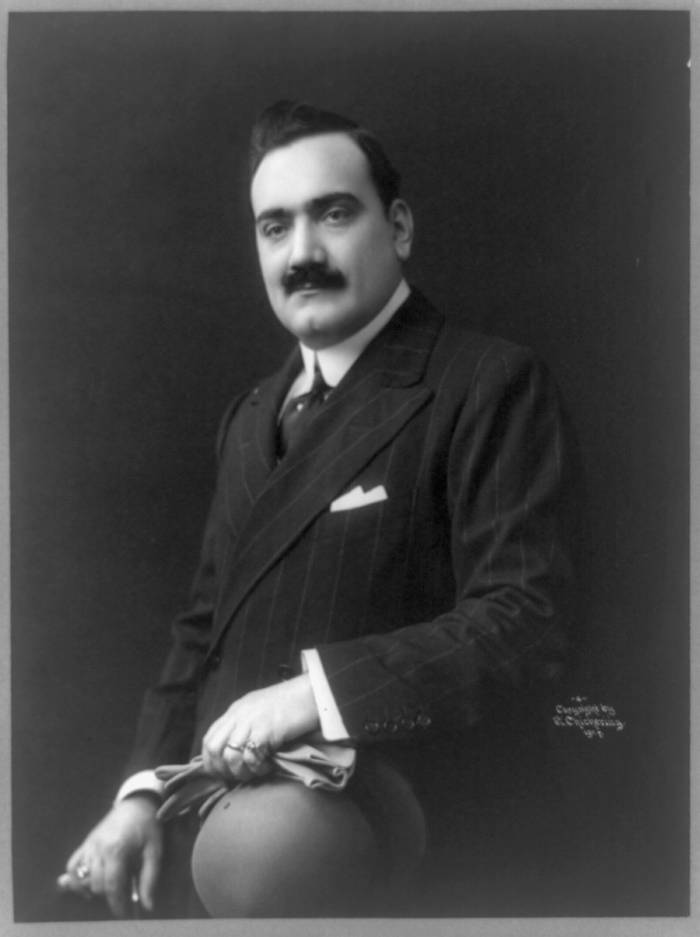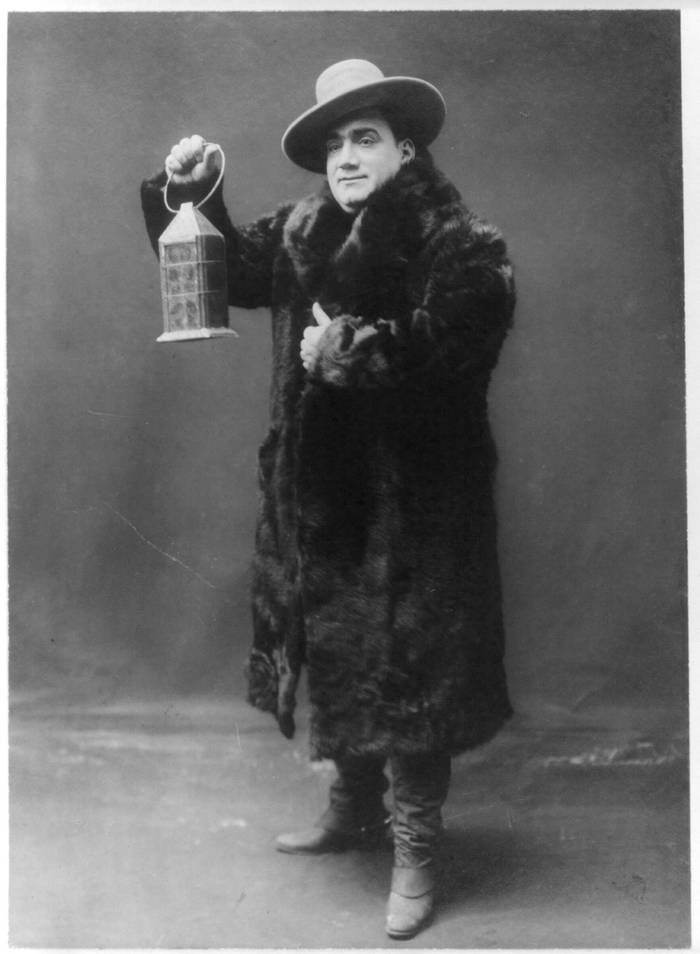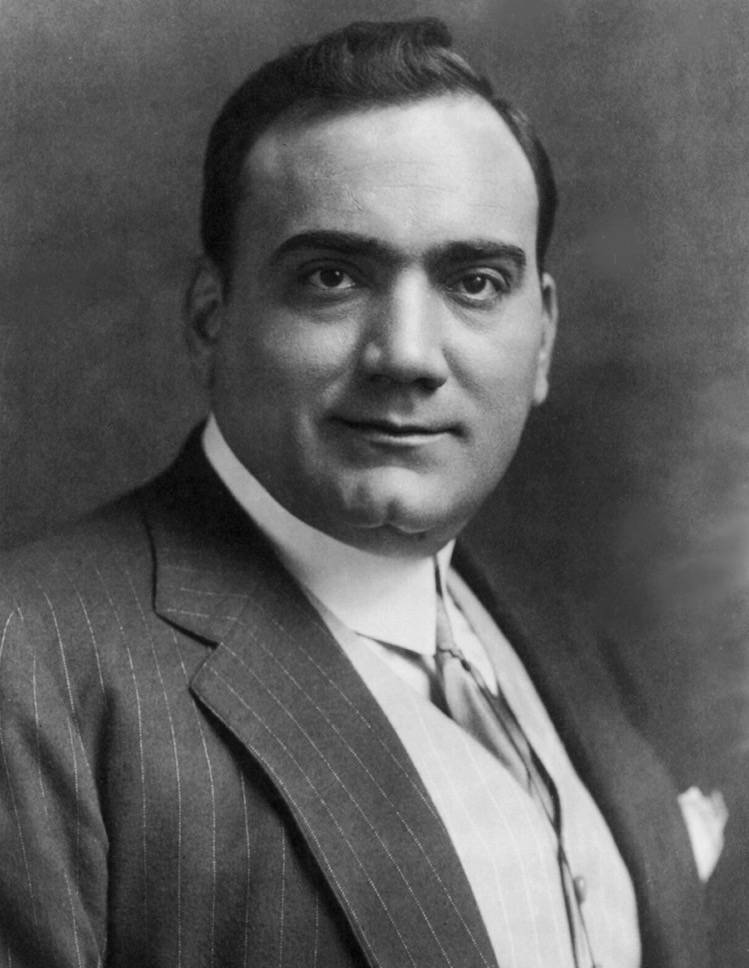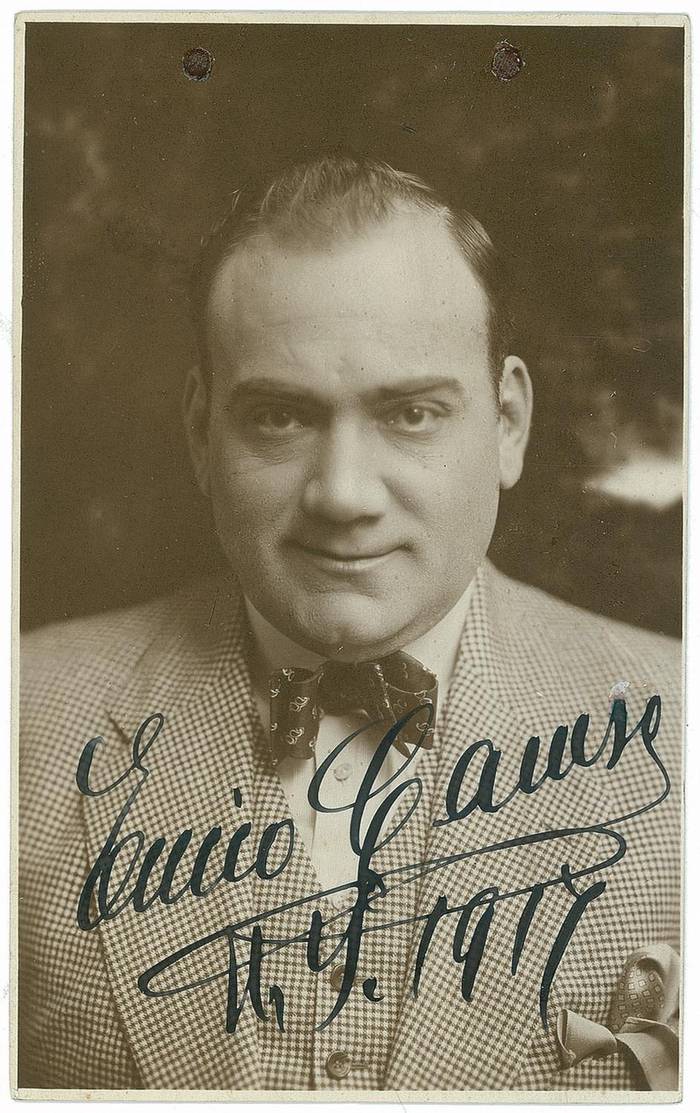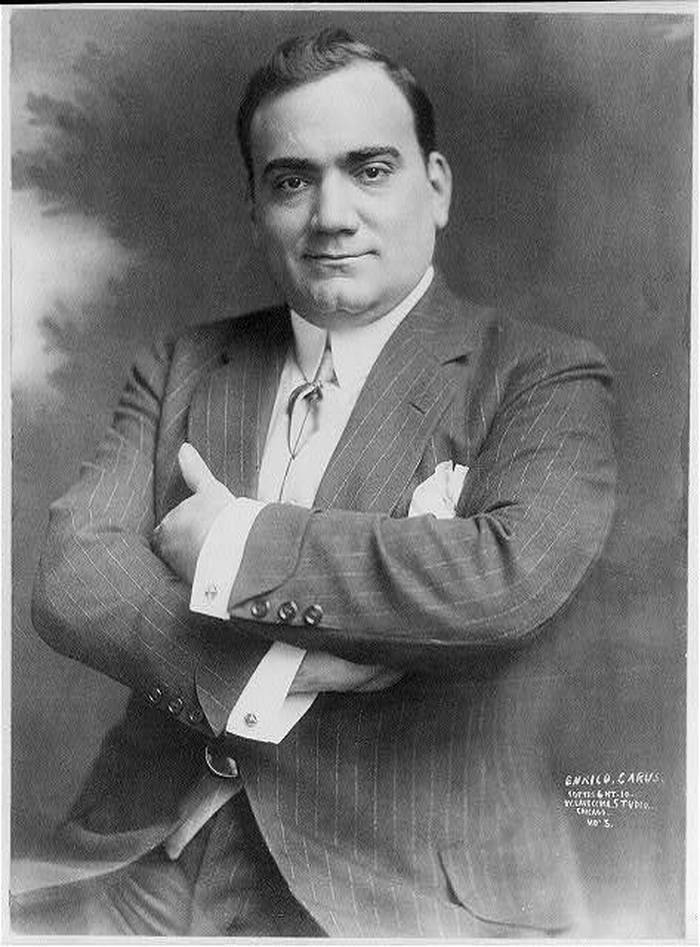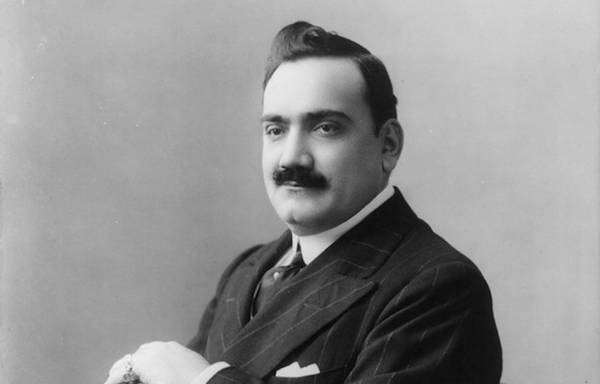Overview
Photos
Biography
Enrico Caruso (Italian pronunciation: [enˈriːko kaˈruːzo]; 25 February 1873 – 2 August 1921) was an Italian operatic tenor. He sang to great acclaim at the major opera houses of Europe and the Americas, appearing in a wide variety of roles from the Italian and French repertoires that ranged from the lyric to the dramatic. Caruso also made approximately 260 commercially released recordings from 1902 to 1920. All of these recordings, which span most of his stage career, remain available today on CDs and as downloads and digital streams.
Early life
Enrico Caruso came from a poor but not destitute background. Born in Naples in the Via San Giovannello agli Ottocalli 7 on 25 February 1873, he was baptised the next day in the adjacent Church of San Giovanni e Paolo. His parents originally came from Piedimonte d'Alife in the Province of Benevento (now called Piedimonte Matese), in the Province of Caserta in Campania, Southern Italy.[citation needed] Called Errico in accordance with the Neapolitan language, he would later adopt the formal Italian version of his given name, Enrico ("Henry" in English). This change came at the suggestion of a singing teacher.
Caruso was the third of seven children and one of only three to survive infancy. There is a story of Caruso's parents having had 21 children, 18 of whom died in infancy. However, on the basis of genealogical research (amongst others conducted by Caruso family friend Guido D'Onofrio), biographers Pierre Key, Francis Robinson, and Enrico Caruso Jr. and Andrew Farkas, have proven this to be an urban legend. Caruso himself and his brother Giovanni may have been the source of the exaggerated number. Caruso's widow Dorothy also included the story in a memoir that she wrote about her husband. She quotes the tenor, speaking of his mother, Anna Caruso (née Baldini): "She had twenty-one children. Twenty boys and one girl – too many. I am number nineteen boy."
Caruso's father, Marcellino, was a mechanic and foundry worker. Initially, Marcellino thought his son should adopt the same trade, and at the age of 11, the boy was apprenticed to a mechanical engineer who constructed public water fountains. (Whenever visiting Naples in future years, Caruso liked to point out a fountain that he had helped to install.) Caruso later worked alongside his father at the Meuricoffre factory in Naples. At his mother's insistence, he also attended school for a time, receiving a basic education under the tutelage of a local priest. He learned to write in a handsome script and studied technical draftsmanship. During this period he sang in his church choir, and his voice showed enough promise for him to contemplate a possible career in music.
Caruso was encouraged in his early musical ambitions by his mother, who died in 1888. To raise cash for his family, he found work as a street singer in Naples and performed at cafes and soirees. Aged 18, he used the fees he had earned by singing at an Italian resort to buy his first pair of new shoes. His progress as a paid entertainer was interrupted, however, by 45 days of compulsory military service. He completed this in 1894, resuming his voice lessons upon discharge from the army.
Early career
On 15 March 1895 at the age of 22, Caruso made his professional stage debut at the Teatro Nuovo in Naples in the now-forgotten opera, L'Amico Francesco, by the amateur composer Mario Morelli. A string of further engagements in provincial opera houses followed, and he received instruction from the conductor and voice teacher Vincenzo Lombardi that improved his high notes and polished his style. Three other prominent Neapolitan singers taught by Lombardi were the baritones Antonio Scotti and Pasquale Amato, both of whom would go on to partner Caruso at the Met, and the tenor Fernando De Lucia, who would also appear at the Met and later sing at Caruso's funeral.
Money continued to be in short supply for the young Caruso. One of his first publicity photographs, taken on a visit to Sicily in 1896, depicts him wearing a bedspread draped like a toga since his sole dress shirt was away being laundered. At a notorious early performance in Naples, he was booed by a section of the audience because he failed to pay a claque to cheer for him. This incident hurt Caruso's pride. He never appeared again on stage in his native city, stating later that he would return "only to eat spaghetti".
During the final few years of the 19th century, Caruso performed at a succession of theaters throughout Italy until in 1900 he was rewarded with a contract to sing at La Scala. His La Scala debut occurred on 26 December of that year in the part of Rodolfo in Giacomo Puccini's La bohème with Arturo Toscanini conducting. Audiences in Monte Carlo, Warsaw and Buenos Aires also heard Caruso sing during this pivotal phase of his career and, in 1899–1900, he appeared before the tsar and the Russian aristocracy at the Mariinsky Theatre in Saint Petersburg and the Bolshoi Theatre in Moscow as part of a touring company of first-class Italian singers.
The first major operatic role that Caruso was given the responsibility of creating was Loris in Umberto Giordano's Fedora at the Teatro Lirico, Milan, on 17 November 1898. At that same theater on 6 November 1902, he created the role of Maurizio in Francesco Cilea's Adriana Lecouvreur. (Puccini considered casting the young Caruso in the role of Cavaradossi in Tosca at its premiere in 1900, but ultimately chose the older, more established Emilio De Marchi instead.)
Caruso took part in a grand concert at La Scala in February 1901 that Toscanini organised to mark the recent death of Giuseppe Verdi. Among those appearing with him at the concert were two other leading Italian tenors of the day, Francesco Tamagno (the creator of the protagonist's role in Verdi's Otello) and Giuseppe Borgatti (the creator of the protagonist's role in Giordano's Andrea Chénier). He embarked on his last series of La Scala performances in March 1902, creating along the way the principal tenor part in Germania by Alberto Franchetti.
A month later, on 11 April, he was engaged by the Gramophone & Typewriter Company to make his first group of acoustic recordings in a Milan hotel room for a fee of 100 pounds sterling. These ten discs swiftly became best-sellers. Among other things, they helped spread 29-year-old Caruso's fame throughout the English-speaking world. The management of London's Royal Opera House, Covent Garden, signed him for a season of appearances in eight different operas ranging from Verdi's Aida to Mozart's Don Giovanni. His successful debut at Covent Garden occurred on 14 May 1902, as the Duke of Mantua in Verdi's Rigoletto. Covent Garden's highest-paid diva, the Australian soprano Nellie Melba, partnered him as Gilda. They would sing together often during the early 1900s. In her memoirs, Melba praised Caruso's voice but considered him to be a less sophisticated musician and interpretive artist than Jean de Reszke—the Met's biggest tenor drawcard prior to Caruso.
Metropolitan Opera
In 1903, Caruso made his debut with the Metropolitan Opera in New York City. The gap between his London and New York engagements had been filled by a series of performances in Italy, Portugal and South America. Caruso's contract had been negotiated by his agent, the banker and impresario Pasquale Simonelli. Caruso's debut was in a new production of Rigoletto on 23 November 1903. This time, Marcella Sembrich sang opposite him as Gilda. A few months later, he began his lifelong association with the Victor Talking Machine Company. He made his first American records on 1 February 1904, having signed a lucrative financial deal with Victor. Thereafter, his recording career ran in tandem with his Met career, both bolstering each other, until his death in 1921.
Caruso purchased the Villa Bellosguardo, a palatial country house near Florence, in 1904. The villa became his retreat away from the pressures of the operatic stage and the grind of travel. Caruso's preferred address in New York City was a suite at Manhattan's Knickerbocker Hotel. Caruso commissioned the New York jewelers Tiffany & Co. to strike a 24-carat-gold medal adorned with the tenor's profile. He presented the medal in gratitude to Simonelli as a souvenir of his many well-remunerated performances at the Met.
In addition to his regular New York engagements, Caruso gave recitals and operatic performances in a large number of cities across the United States and sang in Canada. He also continued to sing widely in Europe, appearing again at Covent Garden in 1904–07 and 1913–14, and undertaking a UK tour in 1909. Audiences in France, Belgium, Monaco, Austria, Hungary and Germany also heard him before the outbreak of World War I. In 1909, Melba asked him to participate in her forthcoming tour of Australia, but he declined because of the significant amount of travel time that such a trip would entail.
Members of the Met's roster of artists, including Caruso, had visited San Francisco in April 1906 for a series of performances. Following an appearance as Don Jose in Carmen at the city's Grand Opera House, a strong jolt awakened Caruso at 5:13 on the morning of the 18th in his suite at the Palace Hotel. He found himself in the middle of the San Francisco earthquake, which led to a series of fires that destroyed most of the city. The Met lost all the sets, costumes and musical instruments that it had brought on tour but none of the artists was harmed. Holding an autographed photo of President Theodore Roosevelt, Caruso ran from the hotel, but was composed enough to walk to the St. Francis Hotel for breakfast. Charlie Olson, the broiler cook, made the tenor bacon and eggs. Apparently the quake had no effect on Caruso's appetite, as he cleaned his plate and tipped Olson $2.50. Caruso made an ultimately successful effort to flee the city, first by boat and then by train. He vowed never to return to San Francisco and kept his word.
In November 1906, Caruso was charged with an indecent act allegedly committed in the monkey house of New York's Central Park Zoo. The police accused him of pinching the buttocks of a married woman. Caruso claimed a monkey did the bottom-pinching. He was found guilty and fined 10 dollars, although suspicions linger that he may have been entrapped by the victim and the arresting officer. The leaders of New York's opera-going high society were outraged initially by the incident, which received widespread newspaper coverage, but they soon forgot about it and continued to attend Caruso's Met performances. Caruso's fan base at the Met was not restricted, however, to the wealthy. Members of America's middle classes also paid to hear him sing—or buy copies of his recordings—and he enjoyed a substantial following among New York's 500,000 Italian immigrants.
Caruso created the role of Dick Johnson in the world premiere of Puccini's La fanciulla del West on 10 December 1910. The composer conceived the music for Johnson with Caruso's voice specifically in mind. With Caruso appeared two more of the Met's star singers, the Czech soprano Emmy Destinn and baritone Pasquale Amato. Toscanini, then the Met's principal conductor, presided in the orchestra pit.
Extortion by Black Hand
Caruso's success in the Metropolitan Opera drew the attention of Black Hand extortionists. They threatened to injure his throat with lye or harm him and his family if he did not pay them money. He initially paid their extortion fee of $2,000 expecting the matter to be settled, but his willingness to pay made them more brazen. They subsequently demanded an even larger sum of $15,000." He was aided by New York City police detective, Joseph Petrosino, who, impersonating Caruso, captured the extortionists. Antonio Misiano would be later specifically accused of the crime.
Later career and personal life
Caruso's timbre darkened as he aged and, from 1916 onwards, he began adding heroic parts such as Samson, John of Leyden, and Eléazar to his repertoire. Caruso toured the South American nations of Argentina, Uruguay, and Brazil in 1917, and two years later performed in Mexico City. In 1920, he was paid the then-enormous sum of 10,000 American dollars a night to sing in Havana, Cuba.
The United States had entered World War I in 1917, sending troops to Europe. Caruso did extensive charity work during the conflict, raising money for war-related patriotic causes by giving concerts and participating enthusiastically in Liberty Bond drives. The tenor had shown himself to be a shrewd businessman since arriving in America. He put a sizable proportion of his earnings from record royalties and singing fees into a range of investments. Biographer Michael Scott writes that by the end of the war in 1918, Caruso's annual income tax bill amounted to $154,000.
Prior to World War I, Caruso had been romantically linked to an Italian soprano, Ada Giachetti, who was a few years older than he was. Though already married, Giachetti bore Caruso four sons during their liaison, which lasted from 1897 to 1908. Two survived infancy: Rodolfo Caruso (1898-1951) and singer/actor Enrico Caruso, Jr. (1904-1987). Ada had left her husband, manufacturer Gino Botti, and an existing son to cohabit with the tenor. Information provided in Scott's biography of Caruso suggests that she was his vocal coach as well as his lover. Statements by Enrico Caruso, Jr. in his book tend to substantiate this. Her relationship with Caruso broke down after 11 years and they separated. Giachetti's subsequent attempts to sue him for damages were dismissed by the courts.
Towards the end of the war, Caruso met and courted a 25-year-old socialite, Dorothy Park Benjamin (1893–1955). She was the daughter of a wealthy New York patent lawyer. In spite of the disapproval of Dorothy's father, the couple wed on 20 August 1918. They had a daughter, Gloria Caruso (1919–1999). Dorothy wrote two biographies on Caruso, published in 1928 and 1945. The books include many of Caruso's letters to his wife.
A fastidious dresser, Caruso took at least two baths a day and enjoyed good food and convivial company. He forged a particularly close bond with his Met and Covent Garden colleague Antonio Scotti – an amiable and stylish baritone from Naples. Caruso was superstitious and habitually carried several good-luck charms with him when he sang. He played cards for relaxation and sketched friends, other singers and musicians. His wife, Dorothy said that by the time she knew him, her husband's favorite hobby was compiling scrapbooks. He also amassed a valuable collection of rare postage stamps, coins, watches and antique snuffboxes. Caruso was a heavy smoker of strong Egyptian cigarettes, too. This deleterious habit, combined with a lack of exercise and the punishing schedule of performances that Caruso willingly undertook season after season at the Met, may have contributed to the persistent ill-health which afflicted the last year of his life.
Illness and death
On 16 September 1920, Caruso concluded three days of recording sessions at Victor's Trinity Church studio in Camden, New Jersey. He recorded several discs including the Domine Deus and Crucifixus from the Petite messe solennelle by Rossini. These recordings were to be his last.
Dorothy Caruso noted that her husband's health began a distinct downward spiral in late 1920 after he returned from a lengthy North American concert tour. In his biography, Enrico Caruso, Jr. points to an on-stage injury suffered by Caruso as the possible trigger of his fatal illness. A falling pillar in Samson and Delilah on 3 December had hit him on the back, over the left kidney (and not on the chest as popularly reported). A few days before a performance of Pagliacci at the Met (Pierre Key says it was 4 December, the day after the Samson and Delilah injury) he suffered a chill and developed a cough and a "dull pain in his side". It appeared to be a severe episode of bronchitis. Caruso's physician, Philip Horowitz, who usually treated him for migraine headaches with a kind of primitive TENS unit, diagnosed "intercostal neuralgia" and pronounced him fit to appear on stage, although the pain continued to hinder his voice production and movements.
During a performance of L'elisir d'amore by Donizetti at the Brooklyn Academy of Music on December 11, 1920, he suffered a throat haemorrhage and the performance was canceled at the end of Act 1. Following this incident, a clearly unwell Caruso gave only three more performances at the Met, the final one being as Eléazar in Halévy's La Juive, on 24 December 1920. By Christmas Day, the pain in his side was so excruciating that he was screaming. Dorothy summoned the hotel physician, who gave Caruso some morphine and codeine and called in another doctor, Evan M. Evans. Evans brought in three other doctors and Caruso finally received a correct diagnosis: purulent pleurisy and empyema.
Caruso's health deteriorated further during the new year. He experienced episodes of intense pain because of the infection and underwent seven surgical procedures to drain fluid from his chest and lungs. He returned to Naples to recuperate from the most serious of the operations, during which part of a rib had been removed. According to Dorothy Caruso, he seemed to be recovering, but allowed himself to be examined by an unhygienic local doctor and his condition worsened dramatically after that. The Bastianelli brothers, eminent medical practitioners with a clinic in Rome, recommended that his left kidney be removed. He was on his way to Rome to see them but, while staying overnight in the Vesuvio Hotel in Naples, he took an alarming turn for the worse and was given morphine to help him sleep.
Caruso died at the hotel shortly after 9:00 a.m. local time, on 2 August 1921. He was 48. The Bastianellis attributed the likely cause of death to peritonitis arising from a burst subphrenic abscess. The King of Italy, Victor Emmanuel III, opened the Royal Basilica of the Church of San Francesco di Paola for Caruso's funeral, which was attended by thousands of people. His embalmed body was preserved in a glass sarcophagus at Del Pianto Cemetery in Naples for mourners to view. In 1929, Dorothy Caruso had his remains sealed permanently in an ornate stone tomb.
